A brief overview of the importance and fun of bar games
In the bustling social sphere of nightlife, bar games have become an essential part of the whole experience. These games, providing not only a chance to show off skills and enjoy some friendly competition, also facilitate conversation, camaraderie, and a unique brand of fun that simply cannot be replicated elsewhere. Whether you’re a seasoned regular, new to the scene, or just seeking a great night out with friends, the bar games we’re going to explore offer a varied range of entertainment that caters to different interests and skill levels.
Preview of the games to be discussed
In this article, we will dive deep into the top 10 bar games that are bound to enhance your night out. From the classic charm of pool and darts to the fast-paced thrill of foosball and air hockey, we’ve got you covered. We’ll also delve into more unconventional choices like Jenga and Buck Hunter. For each game, we’ll provide a brief history, explain the basic rules, and tell you why it’s considered a fantastic bar game. Furthermore, we’ll offer strategic tips to master these games and guide you on how to choose the best game for your group. So, sit back, grab your drink, and let’s embark on this exciting journey through the realm of bar games.
Understanding Bar Games
Definition and brief history of bar games
Bar games are recreational activities that are typically played in public houses (pubs), bars, taverns, and similar establishments. They can be both physical, like pool or darts, and digital, like arcade games. The history of bar games dates back hundreds of years. For instance, versions of pool have been played since the 15th century, and darts originated in medieval England. As bars evolved to be social gathering places, these games have been incorporated into their environments, leading to the diverse array of bar games we see today. These games have not only withstood the test of time but have also managed to adapt to the changing tastes of generations.
Reasons why people enjoy playing bar games
People enjoy playing bar games for several reasons. Firstly, these games offer an excellent opportunity for social interaction. They act as ice-breakers, helping initiate conversations and create a friendly, competitive atmosphere.
Secondly, bar games can be a fantastic way to relax and unwind. They provide a fun diversion from routine life and allow participants to enjoy themselves in a casual setting.
Thirdly, they add an element of challenge and competition to a night out. The thrill of competing, the suspense of not knowing who will win, and the satisfaction of victory make these games engaging and addictive.
Lastly, many bar games require skill, strategy, and concentration. The sense of achievement that comes from improving and mastering these games is another reason they’re so loved by bar-goers around the world.
Top 10 Bar Games
Pool

Brief History of the Pool
Pool, also known as billiards, traces its origins back to 15th-century Europe, where it began as an outdoor lawn game. The game was eventually moved indoors onto a table with green cloth to mimic the grass, and over the years, evolved into the various forms of billiards we see today. Pool, specifically the variant called “eight-ball”, became popular in the United States in the early 20th century and has been a staple in bars ever since.
Basic Rules of Pool
In a typical game of eight-ball pool, the game starts with a break shot, where the player strikes the rack of 15 balls. The balls are divided into two categories: solid (numbers 1-7) and stripes (numbers 9-15), with the 8 ball being black. Once a player pockets a ball after the break, they are assigned that category of balls (stripes or solids) and aim to pocket all of their assigned balls. The ultimate goal is to legally pocket the 8 ball after clearing all of one’s own balls. However, if a player pockets the 8 ball prematurely or when it’s not a legal shot, they lose the game.
Why Pool is a Great Bar Game
Pool is a fantastic bar game for several reasons. Firstly, it’s a game of skill that offers endless opportunities to improve and show off. Each shot requires careful aim, control, and sometimes, a good understanding of angles and strategy.
Secondly, it’s a social game. A pool table can accommodate 2-4 players, allowing a small group to engage, interact, and compete. The pace of the game encourages conversation and banter, making it a great way to bond with friends or meet new people.
Lastly, the game’s visibility in the bar setting adds to the fun. A well-executed shot or a winning game can catch the eye of onlookers, adding a layer of excitement and spectacle to the experience.
Darts
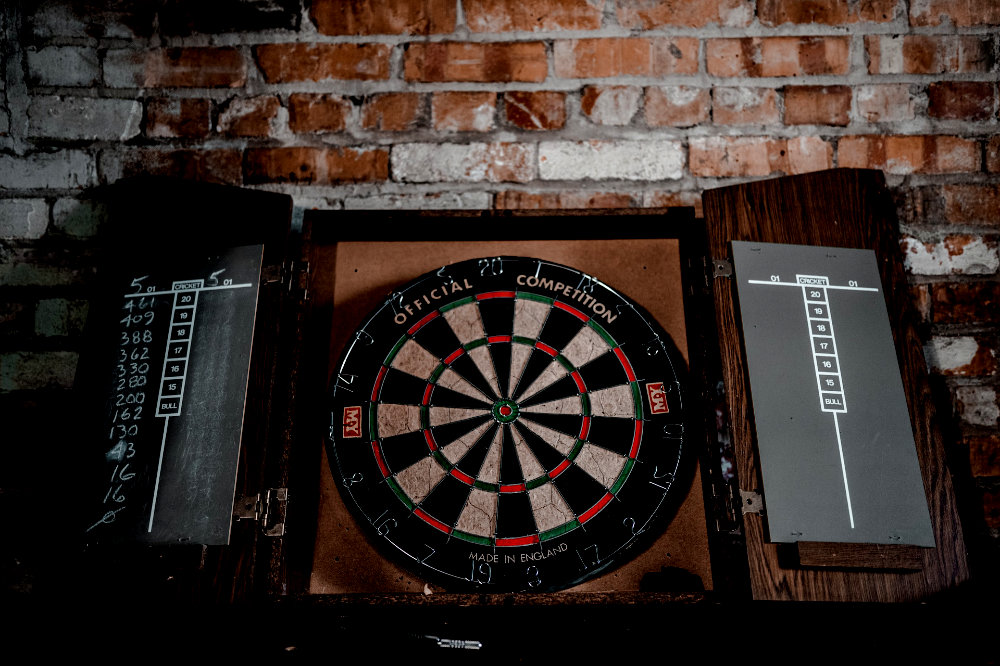
Brief History of the Darts
The game of darts has its roots in medieval England, where soldiers would throw short arrows at the bottom of a barrel or a cut-out section of a tree to improve their throwing skills. The game evolved over centuries and the standardized version of the game we know today, with a circular board and specific scoring regions, was established in the late 19th century. Since then, it’s become a popular game in pubs and bars worldwide.
Basic Rules of Darts
The most common dart game is “501.” Each player starts with a score of 501 and takes turns to throw three darts at the dartboard. The score a player gets from each throw is deducted from their total. The objective is to be the first player to reduce the score to exactly zero, and the final dart must land in either the bullseye or a double segment.
Why Darts Are a Great Bar Game
Darts is a great bar game because it requires skill, concentration, and strategy, but it’s also simple enough for beginners to enjoy. It can be played one-on-one or in teams, which makes it a versatile option for different group sizes. Plus, it doesn’t require much physical space, making it a suitable choice for smaller venues. The thrill of hitting a bullseye or achieving a high score creates an exciting and competitive atmosphere, which adds to the fun of a night out.
Foosball

Brief History of the Foosball
Foosball, also known as table football, was invented in the late 19th or early 20th century, with several people claiming its invention. It was created as a game that replicated football, allowing it to be played indoors. Since its inception, it’s become a common feature in bars, arcades, and recreational rooms.
Basic Rules of Foosball
Foosball is played with two teams, each controlling four rods with figurines attached, representing football players. The objective is to use these figurines to hit a ball into the opponent’s goal. The game is typically played to 5 points, but this can be adjusted depending on player preference.
Why Foosball is a Great Bar Game
Foosball is a high-energy, fast-paced game that can be incredibly exciting to play. It combines elements of teamwork, skill, and a bit of luck, making every game unpredictable and fun. Additionally, it’s easy to learn but difficult to master, offering a level of challenge that keeps players coming back for more. Its compact size means it can fit into most bars, and the side-by-side competition can get very engaging, making it a crowd-pleaser on busy nights.
Pinball

Brief History of Pinball
Pinball’s ancestors can be traced back to games like bagatelle, played in France in the 18th and 19th centuries. Modern pinball, as we know it today, originated in America in the 1930s. These early machines were relatively simple and purely mechanical. Over time, they’ve evolved into sophisticated, electronic gaming devices featuring elaborate graphics, sound effects, and challenging gameplay mechanics.
Basic Rules of Pinball
The aim of pinball is to score as many points as possible by using flippers to hit the ball into different targets on the playfield, such as bumpers, ramps, and holes. Players must keep the ball in play as long as possible and prevent it from draining down the bottom of the playfield. Each machine has its unique set of objectives to earn bonus points.
Why Pinball is a Great Bar Game
Pinball is a perfect bar game because it blends luck and skill, making it accessible for beginners while still providing a challenge for experienced players. The bright lights and sound effects create a spectacle, and a high-scoring game can draw onlookers, adding to the excitement. Plus, it’s a single-player game, allowing patrons to play at their own pace and offering a different dynamic compared to many other bar games.
Air Hockey
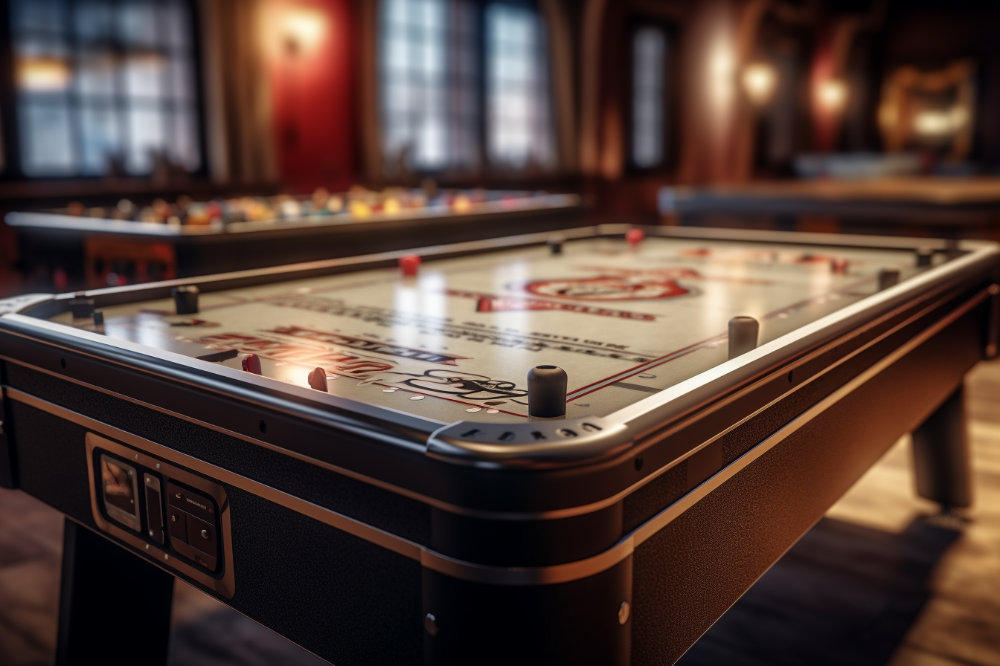
Brief History of Air Hockey
Air hockey was invented in the late 1960s by a group of engineers at Brunswick Billiards who were aiming to create a game that replicated the experience of playing on an ice hockey rink. It became popular in arcades and entertainment centers in the 1970s and has since been a staple in these settings, including bars.
Basic Rules of Air Hockey
Air hockey is played on a table that produces a cushion of air, allowing the puck to glide smoothly across the surface. Each player uses a mallet to hit the puck with the aim of getting it into the opponent’s goal. The game is usually played to 7 points, with each goal counting as one point.
Why Air Hockey is a Great Bar Game
Air hockey is a high-energy, fast-paced game that’s fun to play and watch. It’s easy to learn but requires quick reflexes and strategic thinking, making it engaging for players of all skill levels. The game is typically short, allowing many rounds to be played over a night out. The competitive one-on-one nature of air hockey can get intense and exhilarating, making it a hit in a lively bar atmosphere.
Beer Pong

Brief History of Beer Pong
Beer pong, also known as Beirut, originated at Dartmouth College in the 1950s and 1960s, though it was somewhat different from the game we know today. The modern version of beer pong that involves throwing ping pong balls into cups of beer became popular in the 1980s. It’s since become a fixture at parties, tailgates, and of course, bars.
Basic Rules of Beer Pong
Beer pong is played on a long table, with teams of two at each end. Each team arranges 10 cups in a pyramid shape on their side of the table, each partially filled with beer. Players take turns attempting to throw a ping pong ball into one of their opponent’s cups. If successful, the opposing team must drink the beer from that cup and remove it from the table. The game continues until one team has eliminated all their opponent’s cups.
Why Beer Pong is a Great Bar Game
Beer pong is an excellent bar game due to its easy-to-understand rules, social nature, and the excitement it generates. The game encourages friendly banter and competitiveness between teams. Plus, the added element of drinking makes it a hit in bars and keeps the atmosphere light and fun. It’s also versatile, easily accommodating more players by adding more cups or balls.
Shuffleboard
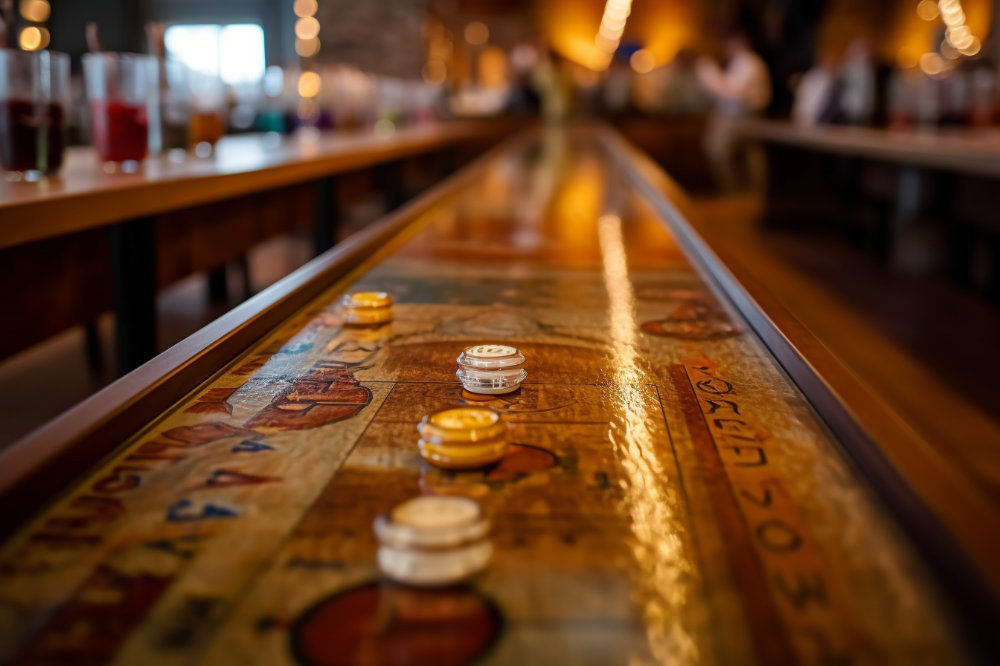
Brief History of the Shuffleboard
Shuffleboard has a long history, with origins dating back to 15th century England. The tabletop version of shuffleboard, often found in bars, became popular on cruise ships in the early 20th century. By the mid-century, it had found its way into American bars, where it remains a popular game today.
Basic Rules of Shuffleboard
Table shuffleboard is played by sliding weighted pucks down a long, smooth wooden table. The table is marked with scoring zones at the end, usually 1-2-3 or 1-3-4. Each player takes turns sliding their pucks to the scoring zones, with the goal of getting as close to the end of the table without falling off. After all pucks are played, the player with the puck closest to the end scores the points for their puck and any other pucks that are closer to the end than their opponent’s nearest puck.
Why Shuffleboard is a Great Bar Game
Table shuffleboard is a great bar game because it’s simple to learn but requires precision and strategy to master. It’s a slower-paced game that promotes social interaction, as players can chat and drink while taking turns. The length of the game can be easily adjusted depending on how much time players want to spend, making it a versatile choice for different types of evenings out. Plus, its low-key nature makes it an excellent choice for those looking for a more relaxed, yet still competitive, game to play in a bar setting.
Jenga

Brief History of Jenga
Jenga, a game of physical skill, was created by Leslie Scott and launched at the London Toy Fair in 1983. The name Jenga is derived from a Swahili word meaning “to build.” Although traditionally not a typical bar game, in recent years it has found its way into many bars as a fun and engaging social game.
Basic Rules of Jenga
Jenga consists of 54 wooden blocks arranged in a tower. Players take turns removing one block at a time from any level of the tower (except the one below an incomplete top level) and placing it on the topmost level. The game continues with players removing and stacking blocks, making the tower increasingly unstable. The game ends when the tower falls, and the last person to successfully place a block is the winner.
Why Jenga is a Great Bar Game
Jenga is an excellent bar game because it’s simple to understand and play, yet it can become incredibly tense and exciting as the tower grows more unstable. It’s a game that encourages conversation and camaraderie, as players often engage in playful trash talk or collectively hold their breath during precarious moves. Jenga games can attract onlookers and create a fun, communal experience in a bar setting.
Ring Toss
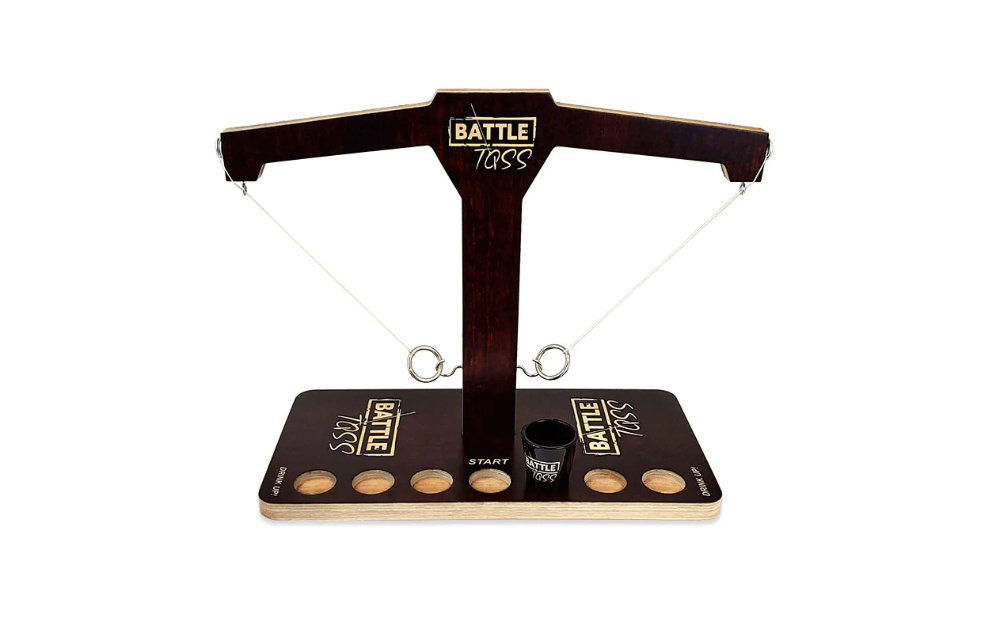
Brief History of the Ring Toss
Ring toss has roots in the ancient carnival game of quoits. It’s believed to have originated in Greece and was later adopted by the Romans. The modern simplified version, ring toss, is a staple of carnivals and fairs and has found its way into some bars as a fun, casual game.
Basic Rules of Ring Toss
In ring toss, players throw rings from a set distance, aiming to land them over pegs or stakes that are fixed on a board or on the ground. Different pegs or stakes are often worth different point values. The goal is to score the highest number of points after a predetermined number of throws.
Why Ring Toss is a Great Bar Game
Ring toss is a great bar game because it’s easy to play, and games can be quick, allowing for multiple rounds or easy rotation among a larger group. It involves both luck and skill, which can make the game exciting and competitive. Plus, it requires minimal physical effort, making it accessible to a wide range of people. As a game, it doesn’t interrupt the conversation and can even be played with a drink in hand, fitting well with the relaxed, sociable atmosphere of a bar.
Big Buck Hunter
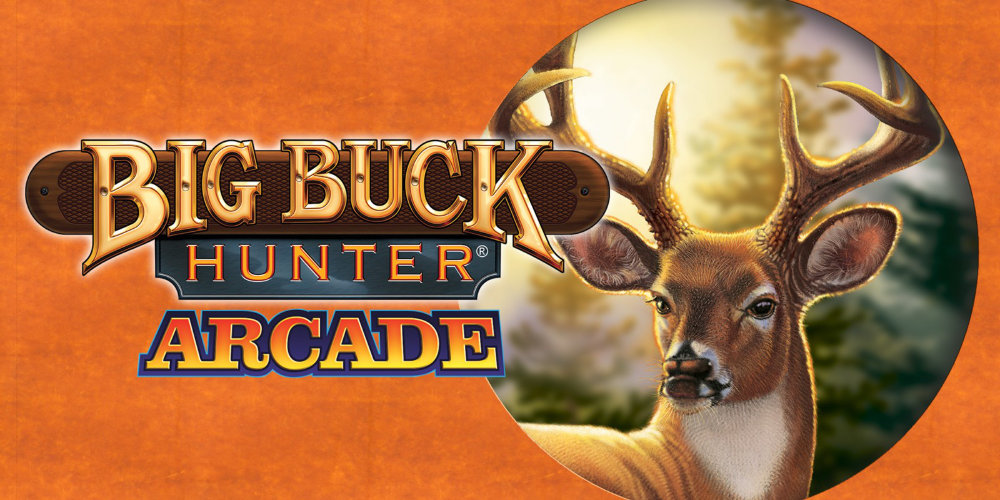
Brief History of Big Buck Hunter
Big Buck Hunter is an arcade-style hunting game developed by Play Mechanix, Inc. The first version of the game, Big Buck Hunter: Shooter’s Challenge, was released in 2000. Since then, various iterations and updates have been released, featuring different animals and landscapes. The game has become a popular feature in many bars and arcades across the world.
Basic Rules of Big Buck Hunter
In Big Buck Hunter, players use a plastic rifle to ‘hunt’ for deer and other games. The goal is to shoot the male animals (bucks) while avoiding the female ones (does). Each stage presents a different landscape with a variety of animals. Points are scored based on the number and type of bucks shot, with additional points awarded for accuracy and consecutive hits without misses or hitting a doe, which ends the player’s turn prematurely.
Why Big Buck Hunter is a Great Bar Game
Big Buck Hunter is a great bar game for several reasons. It’s arcade-style gameplay and light gun controller make it a fun, interactive, and engaging experience. The competitive element of trying to achieve a high score can create an exciting atmosphere and friendly rivalries. Additionally, the game’s rounds are relatively quick, allowing for many players to have a go over the course of the night. Its hunting theme and bright graphics also make it a visually appealing addition to a bar setting.
How to Choose the Best Bar Game for Your Group
Factors to Consider: Group Size, Skill Levels, Interests
The size of your group can significantly influence the type of game that is best. Games like pool, beer pong, and foosball are great for multiple players, while pinball, Big Buck Hunter, and Jenga can accommodate fewer players at a time.
The skill level of your group is also essential. If you have beginners in your group, games like Jenga, ring toss, or beer pong might be more suitable. For more experienced or competitive groups, darts, pool, or Big Buck Hunter could be a hit.
Lastly, consider the interests of your group. If your friends love strategy, consider games like pool or Jenga. If they’re more into quick, energetic games, foosball or air hockey could be the perfect choice.
Suggestions for Varying Scenarios
- Large Group: Beer pong can engage a large group and allows for rotating teams.
- Small Group: Jenga or foosball can be great for smaller groups or pairs.
- Mixed Skill Levels: Choose games with a luck element like ring toss or pinball.
- Competitive Friends: Darts or pool can fuel friendly competition.
- Looking for Fun and Laughter: Games like Jenga or beer pong can provide a lot of fun moments.
- Quick Games: Air hockey or ring toss can be quick, allowing everyone to have a go.
Conclusion
Recap of the Top 10 Bar Games
In this guide, we’ve explored a wide variety of popular bar games that can make your night out even more enjoyable. These games include:
- Pool: A classic game of strategy and skill that can be a centerpiece of any great bar night.
- Darts: Combining skill and precision, darts is a competitive game that can engage players for hours.
- Foosball: A fast-paced, high-energy game that can be both fun to play and watch.
- Pinball: Offering a combination of luck and skill, pinball machines can be a thrilling solo challenge.
- Air Hockey: Quick and competitive, air hockey can deliver high-intensity fun.
- Beer Pong: Mixing competition with socializing, beer pong is a party staple for a reason.
- Shuffleboard: An excellent choice for those seeking a more relaxed yet competitive game.
- Jenga: Offering tension and fun, Jenga is a simple yet exciting game to play.
- Ring Toss: An easy-to-understand game, ring toss is a great choice for large groups.
- Big Buck Hunter: This arcade-style hunting game offers a unique blend of fun and competition.
Try These Games During Your Next Night Out
Next time you’re planning a night out at a bar, consider choosing a venue that offers some of these engaging games. Whether you’re looking for a competitive challenge, a social activity, or just a way to add some extra fun to your evening, these bar games are sure to enhance your experience. Remember, the primary goal is to have fun and enjoy the company of your friends. So pick a game, learn the basics, and have a great time!